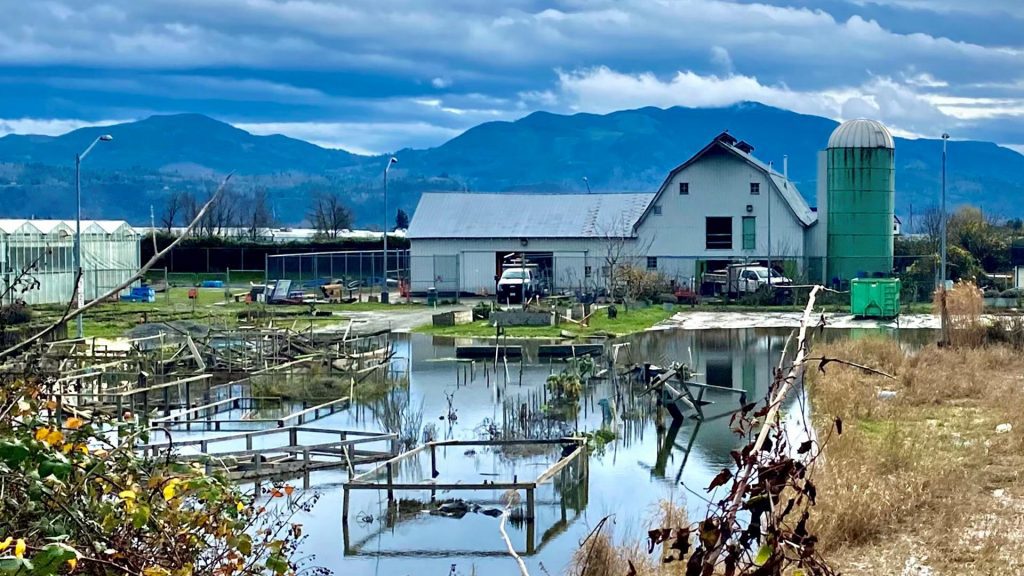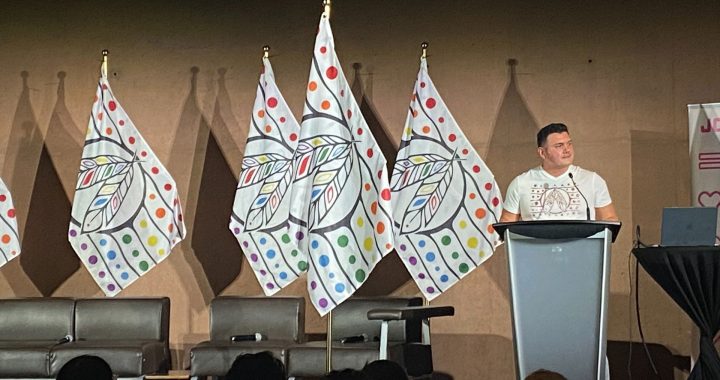
APTN files
One year after the intense weather event called an “atmospheric river,” a senate committee has released a report on British Columbia’s floods saying action needs to be taken now to build flood mitigation infrastructure and manage the cross-border waterway with the US if the province wants to avoid future disasters.
The flood created the potential for ongoing issues in First Nations communities, according to the Senate report on B.C. flooding.
“During the rain event, a number of farmers were caught in mud. They couldn’t get their crops off the field because of the rain. It simply didn’t dry out long enough,” Chief Tyrone McNeil of Sto:lo First Nation said of the torrential downpour the province faced in the 2021 floods.
Similarly, First Nations Emergency Services Society’s Brenden Mercer stated that parts of Coldwater First Nation were flooded, with potential “long-term damage” to farmland due to heavy minerals in the soil as well as the total number of animals that communities can support.
B.C. declared a state of emergency in response to the floods on Nov. 17, 2021. It was lifted two months later on Jan. 18, 2022.
The Standing Senate Committee on Agriculture and Forestry compiled the testimony of 23 witnesses and three written briefs into its report. The report reveals the impact of the floods, gaps in government response and failings in emergency preparedness.
The report does not specifically speak to Indigenous communities as more vulnerable to flooding, but as APTN has reported previously, researchers at the University of Waterloo in Ontario used national data sets on flood hazards, residential address points and census population and the study found that groups such as Indigenous Peoples, females, lone-parent households, South Asians, the elderly, other visible minorities and economically insecure residents are at a higher risk of flooding in Canadian neighbourhoods due to systemic disadvantages.
Investment needs to happen now
Senator Paula Simons said everything they heard suggested that money needs to be invested now. She said delaying the expense will only cost more down the road.
“There is no time for red tape in the immediate aftermath of flooding,” says Simons.
The report made three recommendations.
For the first recommendation the report suggests that provincial and federal governments need to work with First Nations in the Fraser Valley and municipalities to develop a flood mitigation plan. This includes things like upgrading dikes and putting together a multi-government committee.
Secondly, they asked that the federal government ensures all its disaster response and support programs are being delivered in the most efficient way possible, with all the necessary financing and human resources.
Lastly, they asked that the federal government work with the United States on managing transboundary waters such as the Nooksack River.
Majority of region’s dikes won’t hold back flood
“Overflow from the Nooksack River was one of many contributions to the 2021 floods that devastated farmland in British Columbia’s Fraser Valley and upended those communities for months,” said Sen. Mobina Jaffer, who sits
“The Senate committee remains concerned about the potential for the Nooksack River to overflow yet again and urges governments in Canada and the United States to co-ordinate the management of transboundary waters.”
Witness testimony focused on the importance of upgrading the regions dikes. Monica Mannerstrom, the principal flood management engineer for Northwest Hydraulic Consultants Ltd told the committee that “First Nations have inhabited this area for thousands of years. Historically, flooding was not a major issue as the people had seasonal dwellings and moved out of harm’s way during the freshet, or snowmelt season…”said Mannerstrom.
She also told the senate committee the dikes are far from meeting provincial standards. “87% of the dikes in the Lower Mainland were ‘in less-than-fair condition,’ and that 71% of the dikes were ‘expected to fail simply by overtopping’ in the event of a flood,” said Mannerstrom.
Costs in resolving this issue are going to be expensive. Abbotsford mayor Henry Braun said options his city mapped out in April suggested a price tag between $2.5 billion and $2.8 billion. The senate said part of their recommendations is tasking governments with determining how those upgrades can be paid for.
Farmers still waiting for help
Numerous witnesses told the senate committee provincial and federal supports offered some help, but that it took a long time. Some farmers are still waiting. Jack Dewit, chair of the B.C. Pork Producers’ Association, said six months after the floods many were still waiting for help.
The B.C. government estimated that the flood affected more than 1,000 farms, 15,000 hectares of land and 2.5 million livestock. Damages to farmers alone amounted to $285 million.
Impact extends far beyond the Fraser Valley
While the 2021 floods hit those in the Fraser Valley the hardest, the impacts extended throughout the province and beyond.
The Fraser Valley is one of the most fertile regions in Canada, and is responsible for a large supply of meat, poultry and produce.
Jason Lum, chair of the Fraser Valley Regional District, told the senate committee farms in the Fraser Valley generate almost 40 per cent of the province’s gross annual farm receipts, despite only accounting for 2.4 per cent of B.C.’s farmland.
When the massive rainfall occurred in November, farms were destroyed and there was damage to major transportation routes that move goods throughout the province. Jeremy Dunn, general manager of B.C. Dairy, said a delivery trip that would normally take two hours suddenly turned into 12 to 16 hours following the floods.
The region will flood again
Testimony from the witnesses who spoke at the committee convinced the Senate that future floods are guaranteed to happen in the region.
“We’ll see this happen again and again and again,” Sen. Robert Black said.
The Senators say that they hope the federal government takes their recommendations seriously. They want to see the Fraser Valley damage reduced in the next flood.
“We want people to pay attention,” Simon said.









